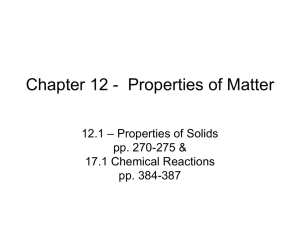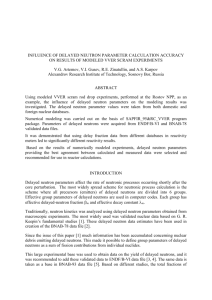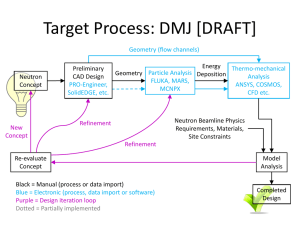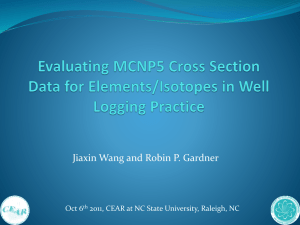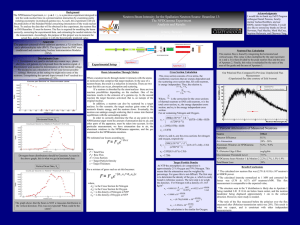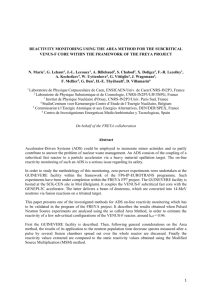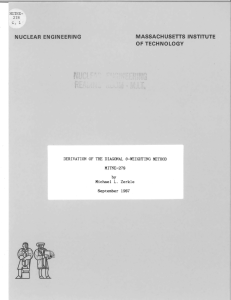The Title Goes Here
advertisement
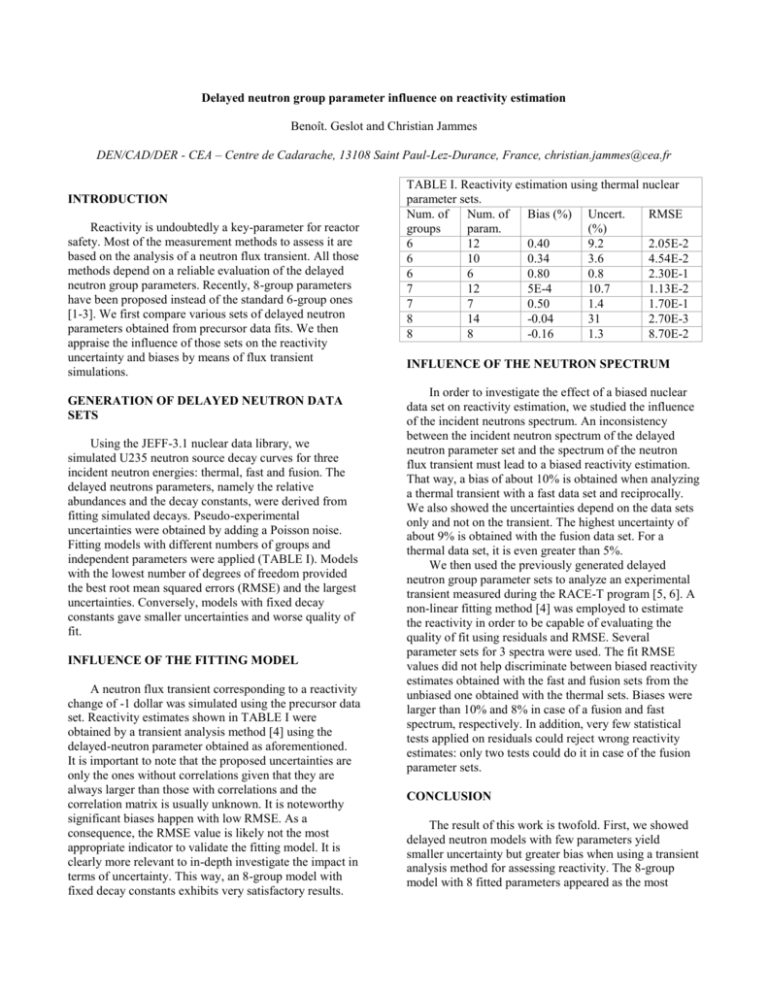
Delayed neutron group parameter influence on reactivity estimation Benoît. Geslot and Christian Jammes DEN/CAD/DER - CEA – Centre de Cadarache, 13108 Saint Paul-Lez-Durance, France, christian.jammes@cea.fr INTRODUCTION Reactivity is undoubtedly a key-parameter for reactor safety. Most of the measurement methods to assess it are based on the analysis of a neutron flux transient. All those methods depend on a reliable evaluation of the delayed neutron group parameters. Recently, 8-group parameters have been proposed instead of the standard 6-group ones [1-3]. We first compare various sets of delayed neutron parameters obtained from precursor data fits. We then appraise the influence of those sets on the reactivity uncertainty and biases by means of flux transient simulations. GENERATION OF DELAYED NEUTRON DATA SETS Using the JEFF-3.1 nuclear data library, we simulated U235 neutron source decay curves for three incident neutron energies: thermal, fast and fusion. The delayed neutrons parameters, namely the relative abundances and the decay constants, were derived from fitting simulated decays. Pseudo-experimental uncertainties were obtained by adding a Poisson noise. Fitting models with different numbers of groups and independent parameters were applied (TABLE I). Models with the lowest number of degrees of freedom provided the best root mean squared errors (RMSE) and the largest uncertainties. Conversely, models with fixed decay constants gave smaller uncertainties and worse quality of fit. INFLUENCE OF THE FITTING MODEL A neutron flux transient corresponding to a reactivity change of -1 dollar was simulated using the precursor data set. Reactivity estimates shown in TABLE I were obtained by a transient analysis method [4] using the delayed-neutron parameter obtained as aforementioned. It is important to note that the proposed uncertainties are only the ones without correlations given that they are always larger than those with correlations and the correlation matrix is usually unknown. It is noteworthy significant biases happen with low RMSE. As a consequence, the RMSE value is likely not the most appropriate indicator to validate the fitting model. It is clearly more relevant to in-depth investigate the impact in terms of uncertainty. This way, an 8-group model with fixed decay constants exhibits very satisfactory results. TABLE I. Reactivity estimation using thermal nuclear parameter sets. Num. of Num. of Bias (%) Uncert. RMSE groups param. (%) 6 12 0.40 9.2 2.05E-2 6 10 0.34 3.6 4.54E-2 6 6 0.80 0.8 2.30E-1 7 12 5E-4 10.7 1.13E-2 7 7 0.50 1.4 1.70E-1 8 14 -0.04 31 2.70E-3 8 8 -0.16 1.3 8.70E-2 INFLUENCE OF THE NEUTRON SPECTRUM In order to investigate the effect of a biased nuclear data set on reactivity estimation, we studied the influence of the incident neutrons spectrum. An inconsistency between the incident neutron spectrum of the delayed neutron parameter set and the spectrum of the neutron flux transient must lead to a biased reactivity estimation. That way, a bias of about 10% is obtained when analyzing a thermal transient with a fast data set and reciprocally. We also showed the uncertainties depend on the data sets only and not on the transient. The highest uncertainty of about 9% is obtained with the fusion data set. For a thermal data set, it is even greater than 5%. We then used the previously generated delayed neutron group parameter sets to analyze an experimental transient measured during the RACE-T program [5, 6]. A non-linear fitting method [4] was employed to estimate the reactivity in order to be capable of evaluating the quality of fit using residuals and RMSE. Several parameter sets for 3 spectra were used. The fit RMSE values did not help discriminate between biased reactivity estimates obtained with the fast and fusion sets from the unbiased one obtained with the thermal sets. Biases were larger than 10% and 8% in case of a fusion and fast spectrum, respectively. In addition, very few statistical tests applied on residuals could reject wrong reactivity estimates: only two tests could do it in case of the fusion parameter sets. CONCLUSION The result of this work is twofold. First, we showed delayed neutron models with few parameters yield smaller uncertainty but greater bias when using a transient analysis method for assessing reactivity. The 8-group model with 8 fitted parameters appeared as the most satisfactory and is highly recommended. Second, we investigated the influence of a biased delayed neutron data set on reactivity estimation. As an example, we showed a reactivity bias due to the use of a delayed neutron parameter set not adapted to the neutron flux spectrum is difficult to identify a posteriori. When using a fitting-based method, only two statistical tests (T-test and the randomness test) for detecting correlations in residuals allowed us to identify biases higher than 8%. Lower biases were unrevealed. The question of how to better detect biases of that sort is thus still open. REFERENCES 1. 2. 3. 4. 5. 6. D. SPRIGGS, J. M. CAMPBELL, Prog. Nucl. Energy, 41, 145 (2002). J. LOAIZA, Nucl. Sci. Eng, 134, 22 (2000). D. SPRIGGS et al., Prog. Nucl. En 41, 223 (2002) B. GESLOT, PhD Thesis, Université Louis Pasteur, Strasbourg, France (2006) G. IMEL et al., “ADS Reactivity Measurements from MUSE to TRADE (and Where Do We Go From Here?) ,” in Int. Conf. PHYSOR 2006, Vancouver, Canada , Sep. 11-14 (2006). C. JAMMES et al., “Absolute Reactivity Calibration of Accelerator-Driven Systems after RACE-T Experiments,” in Int. Conf. PHYSOR 2006, Vancouver, Canada, Sep. 11-14 (2006).

